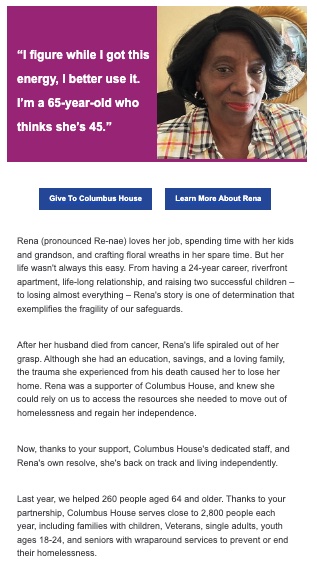While there are many organizations that are leveraging the power of strength-based communication, including Girl Scouts, charity: water and The Arc, some organizations are still hesitant about making the shift. Concerns include that strength-based messaging will negatively impact fundraising, that it’s performative (which of course it can be), it’s time consuming to evolve to this approach, or that you need to move really quickly, and finally that it’s just a fad. While some of these concerns are valid, I’ll address some ways you might overcome them at your organization.
Strength-based messaging will negatively impact fundraising
The most common concern we hear across the board about adopting strength-based messaging is that it will negatively impact fundraising, and without money, organizations can’t advance their missions.
First, the organizations we’ve worked on strength-based messaging have seen that their fundraising remains the same or increases following the adoption of strength-based messaging. One organization, the McCormick Foundation, saw a 13% increase when they put out their first strength-based annual appeal. I believe that there are incredibly compelling ways to leverage strength-based practices to demonstrate when communities (including donors) come together, we can take on some of the world’s greatest challenges. While not perfect, take the example below – a snippet of a strength-based appeal from Columbus House – for how strength-based messaging can encourage donations.
Strength-based messaging is performative
Webster’s dictionary defines performative as “made or done for show (as to bolster one’s own image or make a positive impression on others).” People who call strength-based messaging performative are absolutely right, if organizations adopt strength-based messaging without backing the practice with actions that foster diversity, equity, and inclusion (DEI) within their organizations and communities. The work and actions of organizations and individuals will always speak louder than words. Too often, organizations get excited about making their communication more strength-based, and jump right in without considering that an equitable approach to communication cannot fix an organization with equity issues. Doing so is a Band-Aid, at best. At worst, it may actually inflame cultural tensions that are already smoldering under the surface.
However, for organizations that are doing equity-building work every day, strength-based messaging gives them the resources to communicate about it in ways that are authentic and empowering to those they exist to serve.
Before establishing a strength-based communications strategy, conduct an equity assessment as a first step to identify areas where your organization needs to focus before diving into strength-based messaging.
Strength-based messaging is not succinct
It is true that strength-based messaging doesn’t always allow the communicator to take the easy route. For example, when we write “under-resourced communities,” a phrase like this begs the question, what is it we are actually trying to say? And, since we want to avoid defining people or communities by temporary conditions, these instances require us to elaborate on the systemic inequities at work. That being said, phrases like this can be addressed on a case-by-case basis. For example, maybe you’re writing a piece about students experiencing learning loss as a result of the pandemic, and instead of writing that these learning losses are greatest in “under-resourced communities,” you might write learning losses are greatest in “communities most affected by COVID-19 school closures.”
Moreover, not all strength-based messages need to be long. We’ve developed one-line strength-based appeals. For example, instead of writing, “When you donate you’re building a brighter future,” which is donor-centric, you could write, “Donate and support students in building their bright futures.”
We need to take time to evolve our language to be more strength-based vs. we should have been using strength-based messaging for years
We often hear comments like, “this is a big change, and it’s going to take us a while to shift all of our communications to strength-based.” In the same room, someone else will chime in, “we should have been communicating this way for years, we have to move quickly to make this change.” These two comments reflect the fact that everyone is in a different place on their strength-based messaging journey, and while neither person is necessarily wrong, the organization needs to align about why it is making these shifts and how much it can accomplish by when.
Strength-based messaging is a fad
The most forward-thinking organizations have been moving toward strength-based messaging for years now. Language will always evolve and change, but strength-based practices are here to stay – not just among nonprofits, but corporations, too, that are recognizing the power of lifting up community voice, moving away from over generalizations, bringing together diverse voices as a force for good, sharing how creating equitable opportunities benefits us all and directly addressing race in communication.
What hesitations about strength-based messaging have you experienced at your organization?
